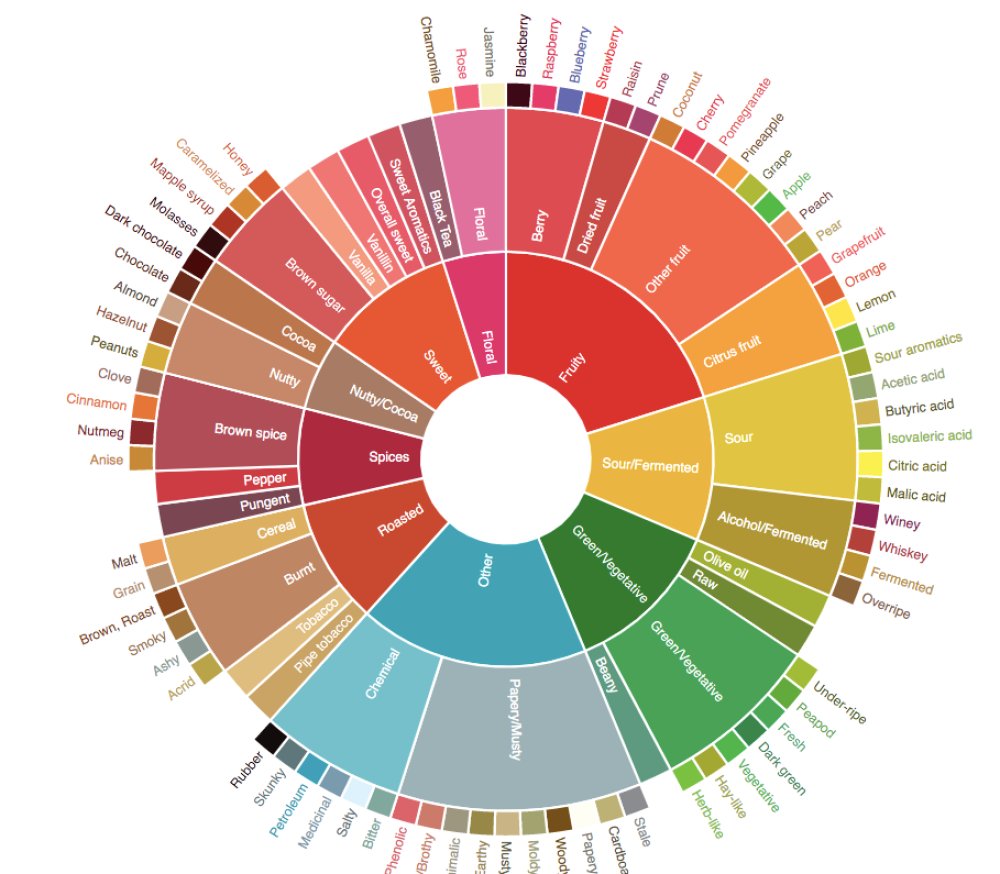In the world of specialty coffee, which has witnessed tremendous growth in recent years, distinguishing flavors has become an art and a science that combines the senses and knowledge. With the spread of coffee culture in the Arab region, where specialty coffee consumption exceeds millions of cups daily, coffee lovers seek a deeper experience than just drinking a cup. Coffee contains a vast variety of flavors, making distinguishing them an essential skill for café owners, baristas, and consumers alike, enhancing product quality and raising brand value.
In this article, we'll explore how to identify coffee flavors like a pro, with a comprehensive guide covering tools, steps, and influencing factors. We'll focus on the coffee flavor wheel as a key tool, with practical examples and tips for beginners. We'll also address the most frequently asked questions on the topic and highlight how Luxury Coffee can be your ideal source for the best flavors through its wide range of specialty coffees, both for cafes and personal use. Our goal is to transform your coffee experience into a pleasurable and rewarding sensory journey.
Understanding the Coffee Flavor Wheel: The Essential Tool for Professionals
The coffee flavor wheel is a visual map that helps systematically categorize and distinguish flavors. The wheel starts at the center with general categories like "fruity" or "spicy," then branches outward to more specific descriptions, such as "blueberry" or "cinnamon." This wheel transforms tasting from intuition into science, helping coffee shop owners choose the right coffee for their customers.
To use it, start by tasting the coffee and determining the general category: Do you sense fruity acidity or chocolatey sweetness? Then move on to the details. For example:
- Main categories include “fruits” (such as citrus or berries), “flowers” (such as jasmine), “spices” (such as cloves), “nuts” (such as almonds), and “sweets” (such as caramel).
- Specific examples : In an Ethiopian coffee, you might identify “lemon” from the citrus category, while in a Colombian coffee, “dark chocolate” stands out from the sweet category.
This wheel makes tasting an organized experience, helping to accurately describe flavors and increase customer satisfaction.
Professional Tasting Steps: A Step-by-Step Guide
To taste coffee like a pro, follow a process called "cupping," used by international coffee associations. Here are the detailed steps:
- Preparation : Choose fresh, coarsely ground coffee (e.g., sea salt). Use 8.25g per 150ml of hot water (93°C). Let it steep for 4 minutes without stirring.
- Fragrance/Aroma Evaluation : Smell the dry coffee first, then after pouring. Dry aromas reveal roasting, while wet aromas highlight base notes. Do you smell floral or nutty?
- Flavor : Take a large slurp to distribute the coffee across your tongue. Focus on the flavors: acidity, like lemon, makes your mouth water, while bitterness, like dark chocolate, makes your mouth water.
- Body Rating : The way coffee feels in the mouth, from light like tea to thick like whole milk.
- Aftertaste : What remains after swallowing. Is it long and sweet or short and dry?
- Balance and Complexity : Do the flavors blend together? Good coffee has multiple layers, such as a transition from fruit to chocolate.
Practicing these steps regularly, especially with side-by-side comparisons between different types, develops the senses quickly.
Factors affecting coffee flavors
Flavors don't come randomly; they're the result of multiple factors:
- Origin : Ethiopian coffee is rich in tropical fruits due to the high altitude, while Brazilian coffee is nutty due to the fertile soil.
- Processing : Wet processing enhances acidity, while dry processing adds ripe, fruity flavors.
- Roasting : Light roasting preserves the original flavors, while dark roasting adds smoke.
- Grinding and Preparation : A fine grind increases extraction, bringing out additional flavors.
Understanding these factors helps in choosing the right coffee for each occasion.
Practical examples of flavor discrimination
Let's put that into practice: In a Kenyan coffee, you might notice the acidity of blackberries with a floral touch, while in an Indonesian coffee, spices like cinnamon stand out with a thick body. Try comparing Arabica with Robusta: the former is complex and fruity, the latter is stronger and earthier.
Top Frequently Asked Questions About Differentiating Coffee Flavors
Based on the experiences of coffee lovers, here are the frequently asked questions:
- How do I get started with coffee tasting if I'm a beginner? Start with the flavor wheel and taste different types side by side.
- What's the difference between flavor and smell? Smell is what you smell, while flavor includes the taste and feeling.
- Can the senses be developed? Yes, with daily practice and training.
- Why do flavors vary within the same variety? Because of the origin, processing, and roasting.
- How do I avoid common mistakes? Avoid cold coffee or coffee mixed with sugar first.
- What's the best tool for beginners? A flavor wheel, available for free online.
- How do I choose good tasting coffee? Choose from trusted sources like Luxury Coffee.
Coffee Luxury: Your Source for the Finest Flavors
For the best coffee flavors, choose from the extensive "Rafia Coffee" collection, which includes varieties from Ethiopia (fruity), Colombia (chocolate), and Indonesia (spicy). As a specialized Saudi institution, "Rafia Coffee" offers fresh coffee with precise flavor recipes, in addition to consulting coffee shop owners to choose the most suitable. With its regular offers and fast delivery, you will be able to easily distinguish flavors and elevate your project or personal experience.
Distinguishing coffee flavors like a pro is a skill that can be acquired with practice and the right tools, opening new doors to enjoyment and commercial success. Start today with the Flavor Wheel and Cupping Steps, and explore the "Coffee Luxury" collection of top choices. With this skill, you'll turn every cup into a unique flavor story.

